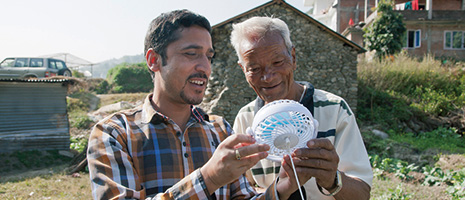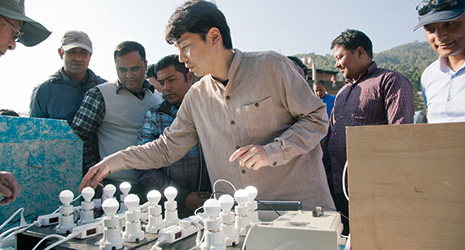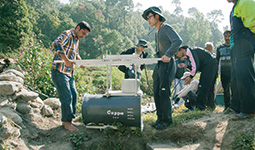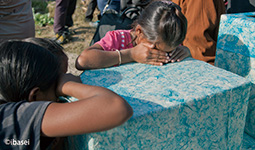Home > Highlighting JAPAN > Highlighting Japan November 2017 > SMEs Overseas
Highlighting JAPAN


Generating Electricity from Rivers and Streams
A small hydro-kinetic power generator manufactured by a small and medium enterprise (SME) in Hitachi City, Ibaraki Prefecture, is bringing power to remote parts of Nepal that lack a stable electricity supply.
Cappa+++ (hereafter Cappa) is an innovative, small hydro-kinetic power generator that transforms the concept behind traditional hydroelectric generators. Developed by ibasei, the unit, which weighs 57 kg, is portable, and when placed in a river or water channel at least 50 cm deep can generate a stable supply of electricity with water flow speeds of as low as 1.5–2.0 meters per second.
Norio Kikuchi (D.Phil.), President and CEO, representative director of ibasei, explains its features.
“Typically hydroelectric power is generated from the potential energy of water stored in a dam or similar large-scale structure. Cappa requires no such infrastructure and can generate electric power simply by being placed in a river. Cappa is a system for generating electric power using natural energy without any environmental load.”
Cappa’s development was partly inspired by the Great East Japan Earthquake of 2011.
“The power blackout in Hitachi City continued for six days. We were most concerned about the lack of electric power, because there was no light at night, and we were unable to obtain information as we could not recharge our mobile phones or watch TV. Even during a disaster, if a minimal amount of electric power can be secured, such concerns would be eliminated,” reflects Kikuchi.
Kikuchi completed a doctoral course in theoretical physics at Oxford University, and then became engaged in research on complex fluids at university and research institutions in Germany and in Bangalore, a large city in India where IT-related companies and research facilities are concentrated. In Bangalore, power blackouts occur frequently, and Kikuchi learned firsthand how people are inconvenienced by an unstable power supply. His experience was another driving force behind the development of Cappa.
Founded by Kikuchi’s grandfather in 1946, ibasei is a typical SME, employing about 100 workers and with capital of 30 million yen (US$260,000). Since its foundation, as a partner of the Hitachi Group, one of Japan’s major home electric appliance manufacturers, ibasei has been involved in developing and manufacturing a wide range of motors and power generators. Kikuchi, a theoretical physicist who chose to continue the family business, takes pride in his company.
“The company is small,” he says “but we are a focused group of specialists in motors and generators.”
After the Great East Japan Earthquake, Kikuchi launched the “earth milk project” in the company under the slogan “Leave Abundant Earth for the Future.” Its fundamental concept is to consider natural energy as “earth milk,” which is a blessing from the earth, and to develop products that utilize natural energy without any environmental load using the technology and know-how that the company has accumulated since its foundation. “We adapted cutting-edge turbine technology that is also employed in Formula 1 racing and in the aircraft industry, working for about two years until the completion of our first in-house product, Cappa,” Kikuchi explains.
“Cappa is named after the K in keisuiryoku (light-water-power), which is pronounced “kappa” in Greek. In Japanese folklore, the kappa is an impish creature found living near water, and being well-known by Japanese people helps make the product name easy to remember.”
In 2014, ibasei applied to the Support for Japanese SMEs Overseas Business Development in ODA Project from the Japan International Cooperation Agency (JICA), specifically to survey the potential and issues of Cappa in Nepal. Hydroelectric generation that uses the abundant water resources in the Himalayas is the main source of power in Nepal, but the electrification rate in rural parts of the country is still low. Power blackouts that continue for up to 10 hours a day are common even in urban areas.
When Kikuchi demonstrated Cappa in Nepal and successfully turned on a lightbulb array using the equipment, local people shouted with joy and burst into applause. Those involved in schools and hospitals, as well as local government representatives, said they wanted to use Cappa as soon as possible.
Following the good response to this survey, in April 2017 ibasei initiated a “pilot survey for disseminating SMEs’ technologies” for two years in Nepal to test the effectiveness of Cappa. In the trial, Cappa supplies electric power to schools and the surrounding community in a non-electrified area and where power supply had been unstable, aiming to improve the educational environment and overall standard of living.
“We plan to locally manufacture some of the parts used in one of the six units of Cappa to be introduced in Nepal. Issues still remain in terms of parts procurement, but by establishing a local production system in the future, we aim to lower the cost, promote regional development, and further spread Cappa to surrounding countries for export from Nepal,” says Kikuchi enthusiastically.
An in-house project launched by specialists with firsthand experience of life without electric power is beginning to empower people where electrical outages are an everyday occurrence.
© 2009 Cabinet Office, Government of Japan








